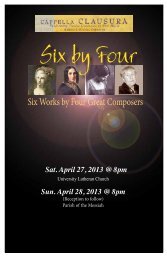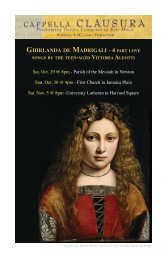The Female Mozart? - Cappella Clausura
The Female Mozart? - Cappella Clausura
The Female Mozart? - Cappella Clausura
You also want an ePaper? Increase the reach of your titles
YUMPU automatically turns print PDFs into web optimized ePapers that Google loves.
Together with this remarkable work, we bring you an exciting and<br />
varied Dixit Dominus by prolific baroque composer Isabella Leonarda, for chorus,<br />
continuo and two violins, which we present with our full orchestra playing<br />
colla parte, i.e. doubling the vocal parts. Leonarda did not score her work for<br />
orchestra, but we feel sure that if she’s had access to one she would have! This<br />
work is typical of the early baroque, sectored by verse into metric divisions of<br />
two or three, reflective of the text. Leonarda was no stranger to word-painting:<br />
listen in particular to her setting of “conquassabit” – fighting words indeed!<br />
And the final “Amen” in 12/8 time is particularly joyous.<br />
Finally, in keeping with our constant search for worthy but unknown<br />
music we present a setting for three choirs of the Dixit Dominus by Juan de<br />
Araujo of Lima, Peru whose works reflect the lush and jaunty baroque style<br />
of the New World. <strong>The</strong> first choir is a trio, and the other two are quartets.<br />
Araujo, as maestro di cappella of a cathedral, would have had a large group<br />
of musicians to choose from for his sacred music. Thus we have added our<br />
full orchestra playing again colla parte. Araujo left out many of the verses of<br />
this setting of the Dixit Dominus, and we have assumed these to be chanted<br />
verses, thus we have inserted chant from the Liber Usualis for those missing<br />
verses. Araujo wrote excellent sacred music as maestro di cappella but his true<br />
love and skill was in writing villancicos, or folk dance pieces. He contributed<br />
many of these wonderful little pieces of rhythmic vitality and invention, and<br />
so inspired our concert’s ending, “Ay andar a tocar a cantar a baylar”. For<br />
this folk tune we have added the characteristic sound of the baroque guitar and<br />
percussion instruments ad lib. “Ay Andar” means, “let’s go sing and play the<br />
drums and the bells!” We hope you are inspired to do just that!<br />
Performing early music primarily written by women has been <strong>Cappella</strong><br />
<strong>Clausura</strong>’s trade, and we are always so amazed at the amount of music that is<br />
available for performance, and even more amazed at the amount that has apparently<br />
been written by women – scholars cite whole catalogs of works – that<br />
for whatever reason is not readily available for performance. We hope that by<br />
championing these works we can inspire more research and transcriptions and<br />
editions. For this performance we are so grateful to Dr. Irving Godt, who died<br />
December 5, 2006, for his excellent edition of the “Dixit Dominus”. We are<br />
also most grateful to to Henry Lebedinsky who has made our edition of Isabella<br />
Leonarda’s “Dixit Dominus”. And we are deeply indebted to the late Robert<br />
Stevenson, who championed the music of the New World, and enlightened us<br />
with the works of many excellent and previously unknown composers. Performing<br />
early music often means making our own performance ready copies, and





